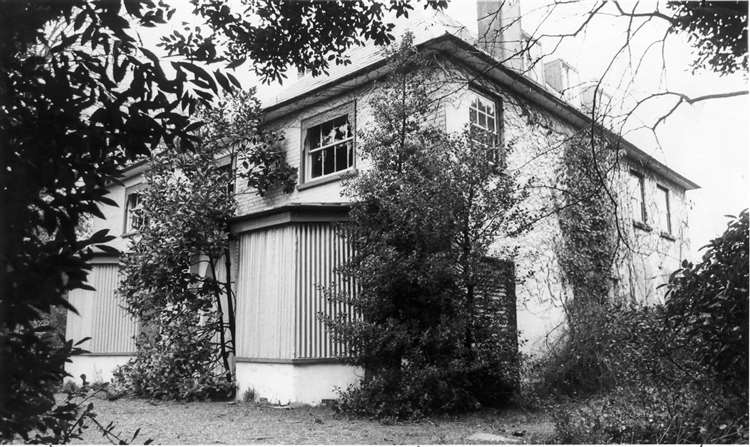THE STORY OF MACKLANDS HOUSE in Station Road, Rainham Kent
The story of Macklands House begins some 300 years ago. The oldest map of Rainham found so far is dated 1735 ,found in the Archives at County Hall, Maidstone in Kent.It shows a farmhouse, a barn and a farm building, marked MACKLAND. In the village, the church is marked with a tower; across the road are the Parsonage and the Vicarage. A map of Kent of 1736, dedicated to Lionel Sackville, shows "Macklands" towards Otterham Creek. The first sign of an owner living there is from the census of 1861, when a Mr.J.B.Ward, an officer at the Sheerness Dockyard with his sister Letitia, aged 21,and two bothers are listed. V.L.B.Ward was a Captain in the 2nd Warwick Regiment and Will Ward was a Surgeon in the Royal Artillery. In 1871 the House was up for sale and no one appeared to be living there. The Estate Agent, Mr.John Trott & Son advertised it as ‘A Freehold House with Land and Stables. Kelly's Directory for 1878 shows the family of Mr.William Wakeley in residence, with his wife Helen, both aged 45, and a daughter Bertha, aged 17. They had a cook, Fanny Wickenden, from London, aged 19 and a housemaid, Julia Paskins, aged18. A brother, Joseph, and his wife Annie were visiting - quite a full house. Around 1880, Mr. Wakeley transfomed the house by adding to the back and making a new entrance facing the garden. This was then laid out 'to lawns, flowerbeds and trees, with a yew hedge to divide the fruit and vegetables from the front portion.
The large garden had a number of trees which included a Wellingtonia, a Cedar, two Horse Chestnuts, a walnut, and a double row of Spanish evergreen Oak trees down the drive.

The four sons all farmed and were known as ‘Wakeley Brothers’, a well known local group of farmers for many years. In 1912, the house was sold to _Mr. E. Bates, who brought his large family from Chatham to enjoy the space and country around.The family took an active part in the village, with helping everyone decorate the church at festivals. One son became the Scout master, and another ran a club for boys, both starting the local Toch H group, above the old Blacksmith‘s and both joined in the local activities. One daughter, Phyllis, was married at St. Margaret's Church in 1935 and the reception was held in the garden of the Macklands. After two World Wars and the family growing up and leaving home, Mr.and Mrs. Bates moved to Birchington in 1946. They sold the house to Mr. and Mrs. Dalton, but they also left in 1947, when Mr. and Mrs. Walter moved to the Macklands with their daughter Angela. They had lived in Rochester and in Gillingham, but found Rainham too far away, although they stayed there until 1957, having sold off part of the top garden in 1954.
When the Mackay-Miller's took the house that year, they worked hard to care for it, and again joined in the local activities, using the garden and the cellars of the house. The elder son, Hamish, and the daughter, Pippa, were both married at St. Margaret's Church, with the receptions held in their garden. To save the premises from becoming a building site, the house was sold to the World Property Housing Trust, by Mr. and Mrs. Mackay-Miller, with Preservation Orders on several trees. It has since been discovered, that the family of Sir John Hawkins, who sailed against the Spanish Armada in 1588, lived at the Macklands.
The plans for the Housing Trust were prepared and sent to Gillingham Council, which then took a further 18 months to approve them. Sadly, there was a long delay in the rebuilding and a great deal of damage was done by vandals. Holes in the roof and broken windows allowed damp to get in, and the gardens became overgrown, and quickly the whole site became derelict. In May 1980, work began on the development for the Housing Group. The house was split into 4 one-bedroom flats on the first floor and a three bedroom flat for a resident Warden/Caretaker,at the top of the house, with a kitchen, guest room and a communal lounge, all on the ground floor. The Cedar tree was cut down to make way for the 16 one-bedroom bungalows built in the grounds. All the units are to be occupied by the elderly. Work was completed on July 27th 1981. Some residents moved in that year and others in 1982. The Mayor of Gillingham, Councillor Harry Blease, unveiled the plaque and a vote of thanks proposed by Mr.Mark Cato for the W.P.H.T., and refreshments were served in the Communal Lounge. It is now a very popular housing establishment run by Sanctuary Housing Association.
Vida Bates, April 2001.





































































































